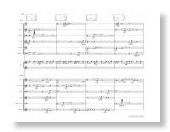rotation
Impulses – 3 (interpretation & performance)
10 08 10 Filed in: notes – no notes

6(a)
In my music impulses are clearly defined and are characterized by their attack, speed and rotation. Impulses within one constellation are basically all the same pitch, although they may occur as noise.The first requirement for the performance of impulses is to place the musicians according to the instructions in the score. A good spatial arrangement is essential for the achievement of the rotation of the impulses. The basic principle is that the musicians pass the impulse on to one another.
The impulse’s attack is always accentuated (though without exaggeration,) short, and clearly perceptible. The speed of the impulse is determined by the interval between entries. These must therefore be performed with as much rhythmic precision as possible.
A rotating impulse moves clockwise or anti-clockwise, and can change direction. This will work particularly well if the musicians are aware of the direction in which the impulse is moving: where is it approaching you from, and in what direction are you going to pass it on? The rotations can assume any number of motion patterns: see the example from Axis/Ashes.
An impulse can be identified in the score by a circled dynamic mark.
All other composed elements of the impulse are secondary: the held impulse tone (i.e. the tone that follows the attack,) dynamics and pitch should be performed as neutrally as possible.
Impulses are seldom tones that should be cut off! Even with short notes the attack leads to an impulse tone that ›stays floating in the air.‹ Where I have notated longer impulse tones, it is purely and simply to show that I do not want silence until the following entry.
The dynamics indicate nothing more than the average volume of an impulse tone within the context, and do not relate to the strength of the attack.
In the case of rotation, the musicians take the impulses over from each other. In this process the differences and alterations in timbre are more important than the pitch, which is no more than a reminiscence of the tone which provides cohesion within this ›Klangfarbenmelodie‹ (melody of sound colours,) which incidentally possesses no melodic quality.
(Translation: Robert Coupe)
 click here to see motion patterns in Axis/Ashes
click here to see motion patterns in Axis/Ashes6(b) Impulsen – 2 (interpretatie en uitvoering)
In mijn muziek zijn impulsen gedefinieerd en profileren ze zich door de aanzet, door de snelheid en door de rotatie. In principe hebben impulsen binnen één constellatie allemaal dezelfde toonhoogte, al kunnen ze ook als ruis voorkomen.Het eerste waarop gelet moet worden bij de uitvoering van impulsen is de opstelling van de musici conform de partituurinstructies. Een goede ruimtelijke opstelling is een voorwaarde om de rotatie van de impulsen te realiseren. Uitgangpunt is dat de musici de impuls aan elkaar doorgeven.
De aanzet van de impuls is, zonder te overdrijven, altijd geaccentueerd, kort, en duidelijk waarneembaar.
De snelheid van de impuls wordt bepaald door de duur tussen de inzetten. Deze moeten dus ritmisch zo exact mogelijk worden uitgevoerd.
Een roterende impuls beweegt met de klok mee of tegen de klok in en kan van richting veranderen. Dit zal extra goed werken als de musici zich bewust zijn van de bewegingsrichting van de impuls: waarvandaan komt hij naar je toe en waarnaartoe stuur je hem door? De rotaties kunnen allerlei bewegingsvormen aannemen: zie het voorbeeld uit Axis/Ashes.
In de partituur is de impuls te herkennen aan een omcirkeld dynamisch teken.
Alle andere gecomponeerde elementen van de impuls zijn bijkomstig: de (aangehouden) impulstoon – dat is de toon die volgt op de aanzet –, dynamiek en toonhoogte moeten zo neutraal mogelijk worden uitgevoerd.
Impulsen zijn zelden tonen die moeten worden afgesneden! Ook bij korte noten gaat de aanzet nog over in een impulstoon die ›in de lucht blijft hangen‹. Langere impulstonen zijn alleen maar genoteerd omdat ik geen stilte wil tot de volgende inzet.
De dynamiek geeft niet meer aan dan de gemiddelde geluidssterkte van een impulstoon binnen de contekst, en betreft niet de sterkte van de aanzet.
In het geval van rotatie nemen de musici de impulsen van elkaar over. Daarbij zijn de timbreverschillen en -veranderingen belangrijker dan de toonhoogte. De laatste is niet meer dan een reminiscentie aan de samenhang gevende toon in deze ›Klangfarbenmelodie‹, die overigens geen melodische kwaliteit bezit.
